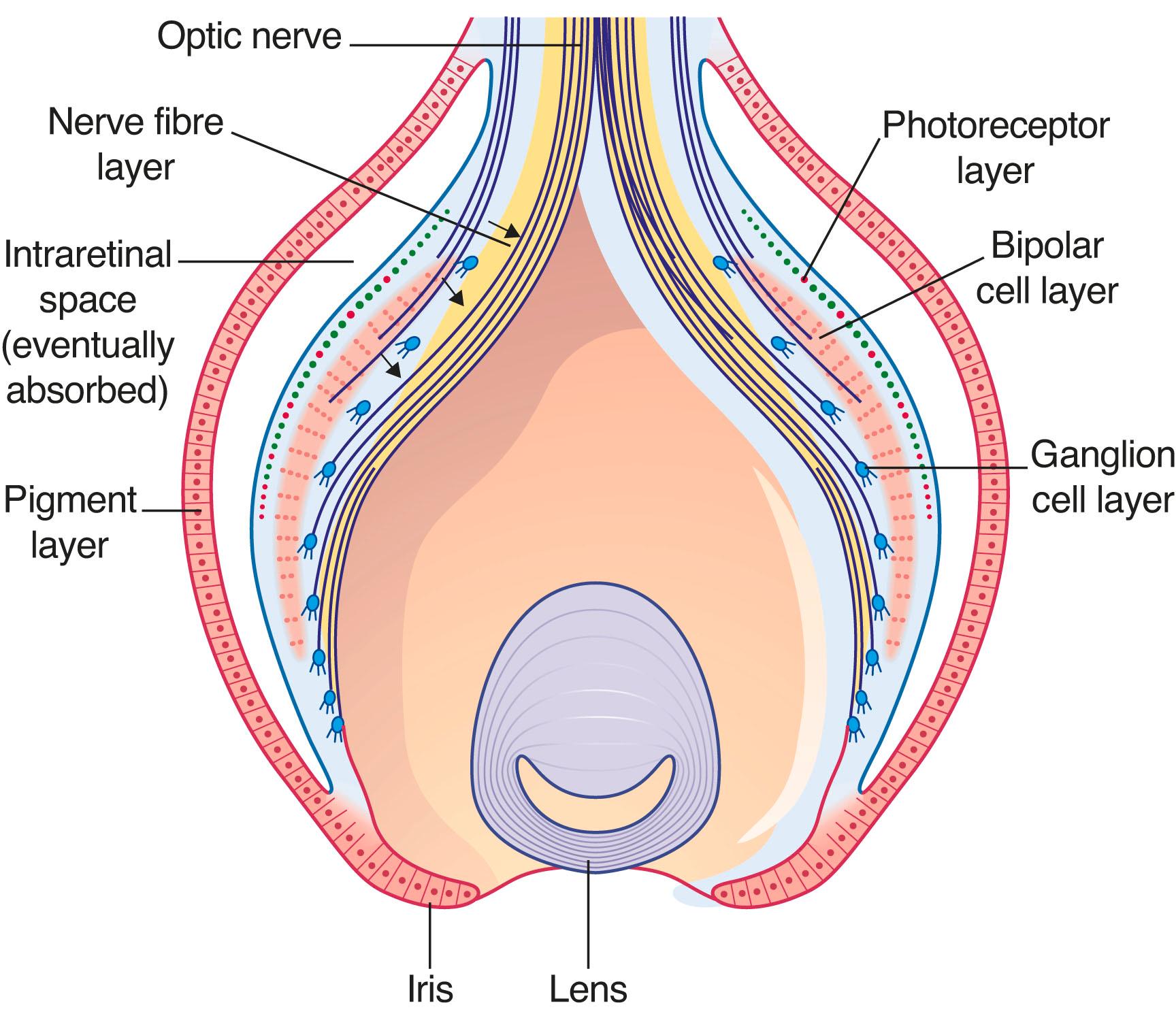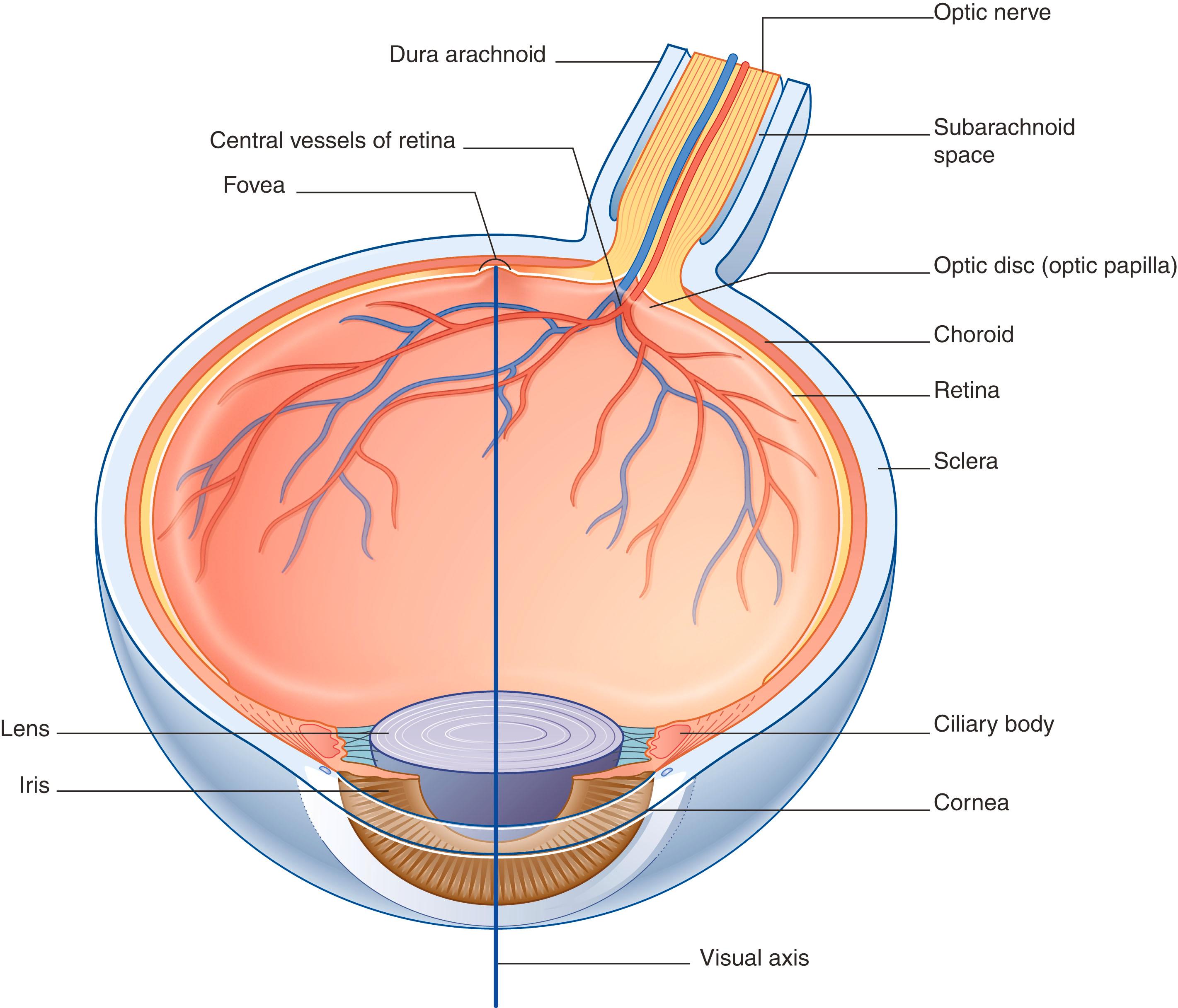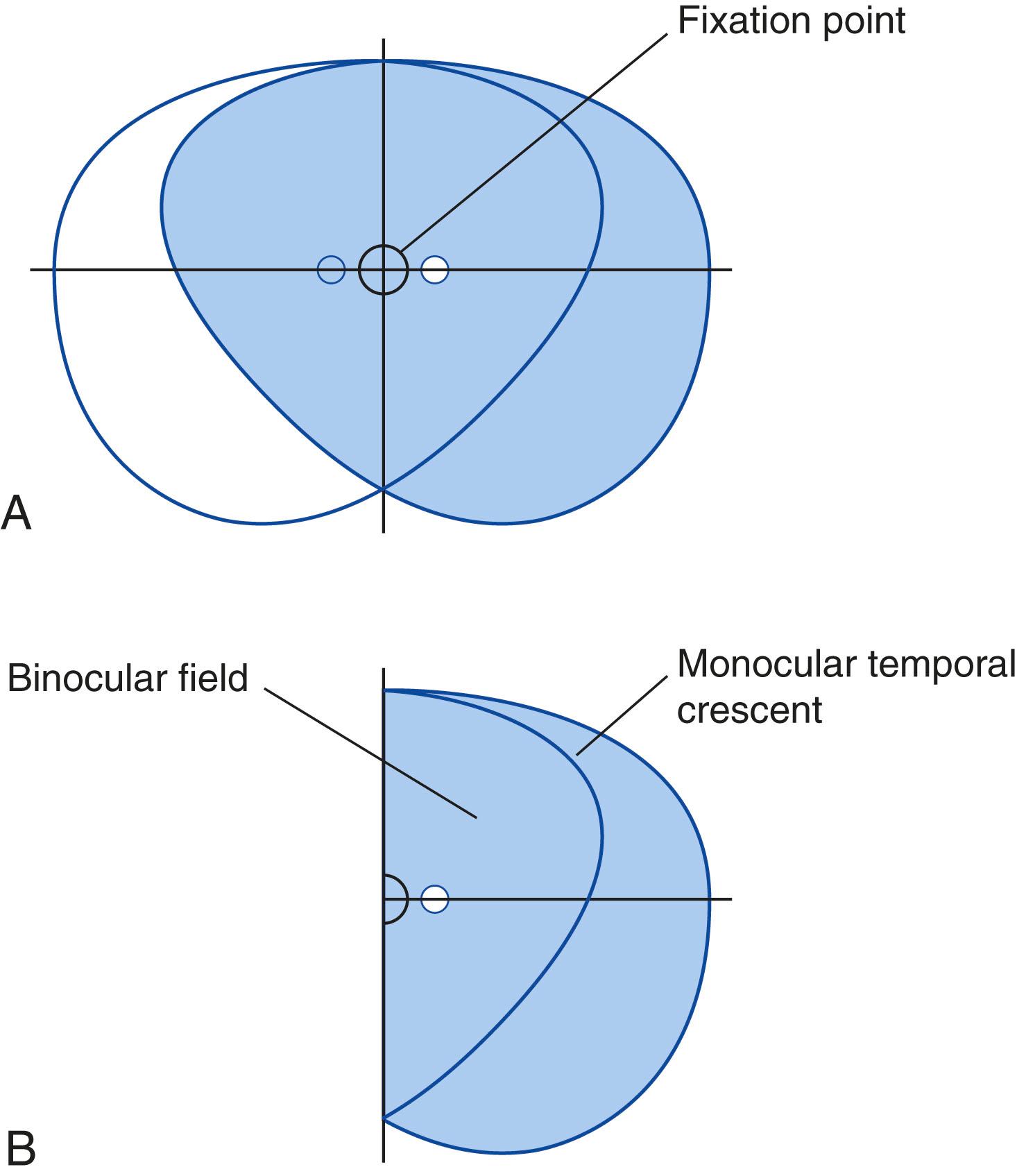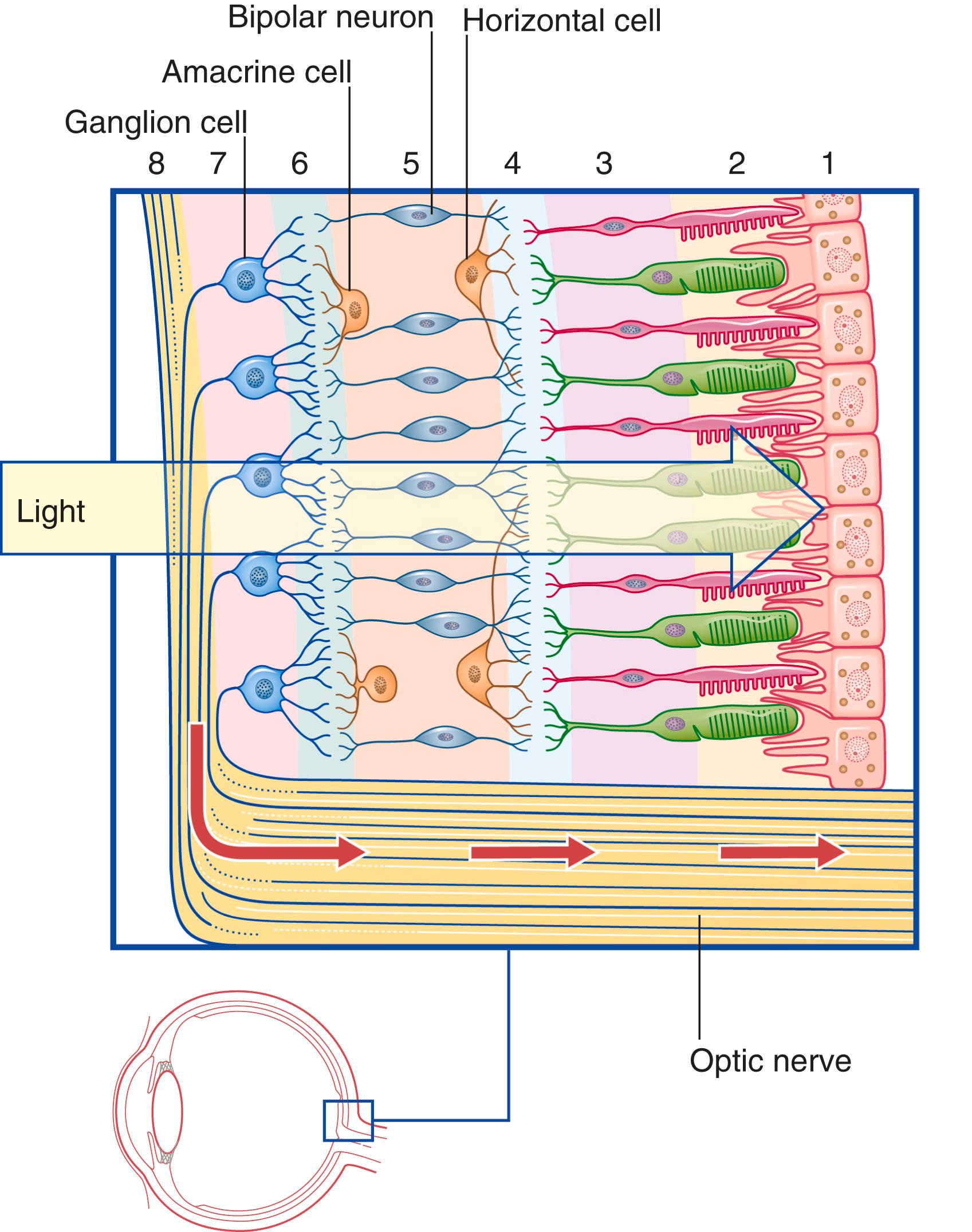Physical Address
304 North Cardinal St.
Dorchester Center, MA 02124
Define the layers of the retina and the cell types located in each.
Contrast a rod versus a cone cell with respect to structure, function, and localisation within the retina.
Be able to trace the pathway from retina to occipital cortex and distinguish between the function of those optic nerve fibres that will end in the midbrain and those that project to the cortex.
Given a visual field pattern, be able to localise the site of involvement within the visual pathway.
Understanding of the details of the visual pathways often proves helpful in the diagnosis of diseases of the forebrain. The visual pathway extends from the retinas of the eyes to the occipital lobes of the brain. Their great length makes them especially vulnerable to demyelinating diseases such as multiple sclerosis, to tumours of the brain or pituitary gland, to vascular lesions in the territory of the middle or posterior cerebral artery, and to head injuries.
The visual system comprises the retinas, the visual pathways from the retinas to the brainstem and visual cortex, and the cortical areas devoted to higher visual functions. The retinas and visual pathways are described in this chapter. Higher visual functions are described in Chapter 28 .
The retina and the optic nerves are part of the central nervous system . In the embryo, the retina is formed by an outgrowth from the diencephalon called the optic vesicle ( Chapter 1 ). The optic vesicle is invaginated by the lens and becomes the two-layered optic cup.
The outer layer of the optic cup becomes the pigment layer of the mature retina. The inner, nervous layer of the cup gives rise to the retinal neurons.
Fig. 31.1 shows the general relationships in the developing retina. The nervous layer contains three principal layers of neurons: photoreceptors , which become applied to the pigment layer when the intraretinal space is resorbed; bipolar neurons ; and ganglion cells , which give rise to the optic nerve and project to the thalamus and midbrain.

Note that the retina is inverted : light must pass through the layers of optic nerve fibres, ganglion cells, and bipolar neurons to reach the photoreceptors. The ‘rationale’ for an arrangement where the photoreceptors are ‘farthest away’ from their source of stimulation, light, or photons, is multifold. First, this arrangement juxtaposes the apical end of the photoreceptors (which houses their light sensitive photopigment) against the retinal pigment layer that can absorb any scattered light or light that does not react with these photoreceptor cells. Second, the retinal pigmented epithelial cells also fulfil a phagocytic role. The light sensitive photopigment within the rod photoreceptor cells has a short half-life and needs to be continually replaced. New photopigment is generated at the base of the rod cells and migrates towards the cell apex, while the aged apical components are shed, phagocytised by the retinal pigmented epithelial cells, and the proteins recycled (cones do not shed). Finally, the photoreceptor cells have a high metabolic rate, and at this innermost retinal position, they are closest to capillaries within the choroid (which underlies this pigment epithelium) that supply their nourishment.
At the point of central vision, the foveola , the bipolar and ganglion cell layers lean away from a central pit (fovea), and light strikes the photoreceptors directly with minimal distortion (see Foveal Specialisation, later). In the mature eye, the fovea is about 1.5 mm in diameter and occupies the centre of the 5 mm wide macula lutea (‘yellow spot’) where many of the photoreceptor cells contain yellow pigment. The fovea is the point of highest visual acuity and lies in the visual axis —a line passing from the centre of the visual field of the eye, through the centre of the lens, to the fovea ( Fig. 31.2 ). To fixate or foveate an object is to gaze directly at it so that light reflected from its centre registers on the fovea.

The axons of the ganglion cells enter the optic nerve at the optic nerve head (optic papilla) , which is devoid of retinal neurons and constitutes the physiologic blind spot .
The visual fields of the two eyes overlap across two-thirds of the total visual field. Outside this binocular field is a monocular (temporal) crescent on each side ( Fig. 31.3 ). During passage through the lens, the image of the visual field is reversed, with the result that objects in the left part of the binocular visual field register on the right half of each retina and objects in the upper part of the visual field register on the lower half. This arrangement is preserved all the way to the visual cortex in the occipital lobe.

From a clinical standpoint, it is essential to appreciate that vision is a crossed sensation . The visual field on one side of the visual axis registers on the visual cortex of the opposite side. In effect the right visual cortex ‘sees the left visual field’ or space and vice versa. Only half of the visual information from each retina crosses in the optic chiasm , as the other half has already crossed the midline before it impinges on the retina of the eye opposite to its origin.
Visual defects caused by interruption of the visual pathway are always described from the patient’s point of view , that is, in terms of the visual fields, and not in terms of retinal topography.
In addition to the serially arranged photoreceptors, bipolar cells, and ganglion cells shown in Fig. 31.1 , the retina contains two sets of neurons arranged transversely: horizontal cells and amacrine cells ( Fig. 31.4 ). A total of eight layers are described for the retina.

The ganglion cells generate action potentials providing the ‘requisite speed for conduction’ to the thalamus and midbrain. For the other cell types, distances are very short and passive electrical charge (electrotonus) or graded changes within their cell membrane potential are sufficient for intercellular communication, whether by gap-junctional contact or transmitter release.
The photoreceptor neurons comprise rods and cones .
Rods function only in dim light and are not sensitive to colour (electromagnetic wavelength energy). They are scarce in the outer part of the fovea and absent from its centre. Cones respond to bright light, are sensitive to colour and to shape, and are most numerous in the fovea. (In the human eye it is estimated that there are 130 million photoreceptor cells; rods outnumber cone cells by 20 to 1 and with the exception of the fovea, are distributed throughout the retina.)
Each photoreceptor cell has an outer and an inner segment and a synaptic end-foot. In the outer segment (light sensing ‘organelle’) there are hundreds of stacked membranous discs (rods) or membrane infoldings (cones) that incorporate a visual pigment ( rhodopsin is the photopigment that absorbs light or photons and initiates a molecular cascade that results in a change in the photoreceptor membrane potential and alters the release of neurotransmitter at its synaptic end-foot; this process is called phototransduction ); new discs are formed in the inner segment of rods and transported to the outer segment; old discs are shed from the apical portion of the outer segment. The synaptic end-foot makes contact with bipolar neurons and horizontal cell processes in the outer plexiform layer .
A surprising feature of the photoreceptors is that they are hyperpolarised by light. During darkness, sodium ion (Na + ) channels are opened, creating sufficient positive electrotonus to cause leakage of the transmitter (glutamate) from their end-feet onto their bipolar neurons. Illumination causes those Na + channels to close and this change in photoreceptor membrane potential is detected by their bipolar neurons. When the receptor becomes hyperpolarised it releases less neurotransmitter as its action was inhibitory; then the bipolar (and horizontal) cells will be depolarised (excited), but if its action was excitatory, those cells will be hyperpolarised (inhibited).
Rod cells are all hyperpolarised by light, so at high levels of illumination their membrane channels are all closed and their contribution to vision is minimal, and vision depends upon the function of the cones.
Cone bipolar neurons are of two types. ON bipolar neurons are switched on (depolarised) by light, being inhibited by transmitter released in the dark. They converge onto ON ganglion cells. OFF bipolar neurons have the reverse response and converge onto OFF ganglion cells ( Fig. 31.5 ). Typically, one cone cell will synapse with a few cone bipolar neurons, but at the fovea it is a one-to-one relationship; each will synapse with one ganglion cell.

Become a Clinical Tree membership for Full access and enjoy Unlimited articles
If you are a member. Log in here